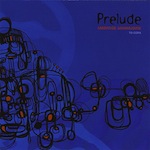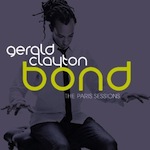Justin Brown
California Drummin'

Justin
Brown born on April 9, 1984 in Richmond, CA, is a musician who enjoys
a successful career. He was raised in California and introduced to
music at an early age by his mother, a gospel organist, and a
supportive father. He later moved to New York. Evolving from playing
churches to clubs in New York is a common path for many musicians,
like Rodney Green, featured in this issue. In 2012, Justin Brown was
a finalist in the Thelonious Monk Competition. These past few years,
Justin Brown has been the regular drummer of Ambrose Akinmusire and
Walter Smith III's quintet. We met him when the band was playing at
the Jazz en Tête festival in Clermont-Ferrand.
Interview & photos by Guy Reynard
© Jazz Hot #669, Autumn 2014
Jazz Hot: Are
the drums your first instrument?
Justin Brown: Yes,
I started off immediately on the drums. In the San Francisco Bay
area, there were a lot of guys who were really, really versed on this
instrument. I was like in a way I had been there to do that. In
church, I was just thrown on this instrument. I just knew by instinct
at a very young age that it was what I wanted to do.

Who
was your first teacher?
Three
guys really started me on my way: first there was Wilson Brooks. He
was a gospel drummer that knew about jazz. There was another guy
–rest in peace– whose name was Dwayne Hendricks. I was about 6 or
7 watching the sky, he was 18 or 19 playing with Pete Escovedo. I was
really brought up into these two guys. And then there was Tommy
Bradford, who was a good friend of my mother. They organized gigs
together in churches in the town. Watching these three guys was
really my first start, my first exposure to this instrument, you
know. Later, I moved to the young musicians program where I learned
how to play in an orchestra.
So,
you studied music?
Yes.
That's how I was introduced to jazz and to great musicians in the San
Francisco Bay area. That's how I met Ambrose but also Joshua Redman.
Sly and the family Stone was also there. There was a lot of great
music in the Bay basically. After that, I studied at the Dave Brubeck
Institute, which is a two-year program at the University of Pacific.
At that time the director was Christian McBride. I was in a heavy
state of development during those two years. It's in Stockton, CA, so
it's in the middle of nowhere and there is nothing else to do but to
work on music. So, I am very thankful for this experience. After that
I decided to go to New York to pursue a musical career. And at that
time I think I was a talented kid but I wanted to work on my craft
and I wanted to develop a thing that was true for me, something I
could express to others in a positive way and not be caught up in
somebody else’s sound. At that age you must be a follower
influences. I know I really wanted to be a jazz musician or a gospel
musician. That's the reason why I moved to New York. In New York,
there are people from all over the world and there are kinds of
music: I can hear gypsy music if I want, Spanish music or reggae.

What
was you church?
We
grew up into Pentecostal Church.
How
different is the music according to the churches?
The
structure of the services is different but the music was similar in
different places. You have your traditional ends but at that time
people like Andrée Crouch, the Hawkins family, the Park Sisters and
other bands reincarnated these tunes in church. Gospel music derived
from the Black church. The Catholic Church is more traditional with
just the choir and the pipe organ. In the Black church, we play all
the instruments.
Who
was your first jazz drummer inspiration?
When
I started the young musicians program, the only thing I knew was
Miles Davis. I don’t think I knew Kind
of Blue. I didn't know what jazz
sounded like. My father had Art Blakey’s Caravan.
That was the first jazz record I listened to heavily and that put me
on my way. Then I listened to a lot of drummers. I started with Art
Blakey and then Tony Williams, Elvin and further back to Big Sid
Cattlett, Cosy Cole and learned the history of the instrument. But
Art Blakey was the first big jazz influence in my life.

I
would say that today in your playing I hear more Elvin Jones than Art
Blakey…
You
never know what you’re going to get, for me I just follow my heart
although there is a lot vocabulary that I’ve studied. I'm not
thinking about it but something of Elvin or Tony Williams or
Roy Haynes can come out. But for me it's about taking all these
things and conveying this information with emotion, textures, feeling
and new answers. For me, it's not about having an approach like Elvin
or Max Roach. It's more about respecting all these things that came
before you and what you studied and then present them in context. But
I think this is a high compliment.
What
were your first professional gigs?
The
first man who gave me my fist professional gig was the famous Cuban
saxophonist by the name of Yosvany Terry. I met him at the Stanford
jazz Workshop. When I was a student they had an intensive program
with little lessons and little concerts. Each faculty member had to
do a concert for the workshop and he asked me to do a gig with him.
Once I met him there he asked me if I would move to New York and I
said yes. I moved to Now York that year. He put me in the direction
of learning African and Cuban music and put them in rhythm. He really
exposed me to another language of playing music in a spiritual way.
After that, there was another guy called Josh Roseman, a trombonist.
He was putting together a new sextet project and asked me to be a
part of that. When I came to New York, I got a scholarship to go to
Juilliard but I didn't go. I spent that first year meeting people,
taking care of myself, learning more about the drums and playing as
much as I could. Later on I played with Kenny Garrett and Christian
McBride. The list of musicians I worked with is beyond what I had
imagined when I arrived...
You're
a permanent member of Ambrose Akinmusire
and Walter Smith III’s quintet…
Yes
I have known him for 17 years now. He is one of the first musicians
that I ever played music with. That's chemistry. I met Walter through
Ambrose years later. I was listening to him all the time on records
and bootlegs and I had never met him but I was very familiar with his
playing. So when the time came to be on the bandstand with him, oh my
God, it's a blessing to be a part of this quintet. We are just
ourselves, we love the history of the music. We have to study. It's
not about showing on the bandstand all the music you know. All that
is about technique, facility. You have to learn where the stuff you
play comes from in order to convey who you are.
You
arrived at the second place of the Thelonious Monk Competition. Could
you describe its process?
This
is the process: they give you a form requirement and you send them an
audition CD that is not longer than 15 minutes. They receive hundreds
of CDs. There are 3 judges that do a blindfold audition and pick 12
semi-finalists. Then they narrow the final to 3. For the semi final,
the panel was Carl Allen, Brian Blade and Terri Lynn
Carrington. They chose 3 musicians for the final.
On that panel, there was Ben Riley Jimmy Cobb and Peter Erskine, guys
I grew up listening to. It was an interesting experience because the
drummers’ community is not really a competitive community. All the
drummers I know love their instrument so much that it's friendly
competition. Nobody tries to beat on each other's head. I was happy
to do that competition and I know that that situation offered a
Prometheus choice. It was more an opportunity than a competition. I
could be the discarded guy but these great musicians. All the 12
semifinalists had great presentation and it could have gone either
way. I went there and showed the judges what I could do. I just
wanted be myself. I just don't want play politics and I was just
happy to make it that far. If I had not practiced and then got second
place, I think I would have been worried. Having had the opportunity
to play with Wayne and Herbie and talk to people like Ben Riley and
Jimmy Cobb makes me feel like a winner. Being there was just
remarkable experience. I was myself and I made it that far and that
was cool, you know.

Do
you have projects as a leader?
Yes
I write music and I recently started to give gigs in New York under
my name but I'm very patient because I just don't want to put music
out there just for my sake. I really want to have something to say to
the world. It's about patience. My group will germinate naturally. I
want to take my time and learn more about who I am, what I want to
present and wait for the music to come in my mind and in my heart to
take a further step towards artistry.
Contact :
www.facebook.com/justin.brown
 Discography Discography
Sideman
CD 2008. Ambrose Akinmusire, Prelude,
Fresh Sound New Talent FSNT 312 CD 2009. Gerald Clayton, Two Shades,
Decca 2707144
CD 2010. Ambrose Akinmusire, When the
Heart Emerges Glistening, Blue Note 509990 70609 2 9
CD 2011. Gerald Clayton, Bond. The Paris
Sessions, EmArcy 15393
CD 2011. Chris Dingman, Waking Dreams,
Baby bwm001
CD 2012. Gerald Clayton, Life Forum,
Concord 7233770
CD 2012. Tony Tixier, Dream Pursuit,
Space Time Records BG 1235
 CD 2014. Ambrose Akinmusire, The
Imagined Savior Is Far Easier to Paint, Blue Note 001972602 CD 2014. Ambrose Akinmusire, The
Imagined Savior Is Far Easier to Paint, Blue Note 001972602
Vidéos
Justin Brown's interview and et concert with the Ambrose Akinmusire Quintet
2012 Thelonious Monk Competiton Concert
*
|

